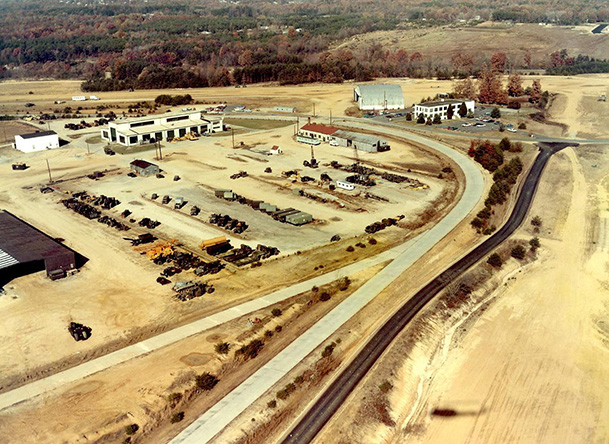
From the Trojan Horse on, creative engineering has been a hallmark of the military. New South Associates conducted oral and archival history research and completed an architectural historical inventory and evaluation of 47 properties of the U.S. Army’s Engineer Proving Ground (EPG) of Fort Belvoir, Virginia.
 Fort Belvoir is named after Belvoir Manor, an eighteenth-century colonial tobacco plantation, originally located on the present site of the fort. Its later transformation and expansion into Fort Belvoir was largely due to American military growth in the early twentieth century. WWII amplified the military challenges encountered during the First World War and created the need for a specialized equipment program. This effort was coordinated through the Corps of Engineers Board at Fort Belvoir, which sought to increase the number of laboratories and experimental locations to test the latest advancements, such as landmines and explosives, infrared and night vision, electronics, advances in transportation, camouflage and paint, and demolition materials. As a result, the EPG was created, an 806-acre parcel of land located northwest of the main portion of Fort Belvoir in Fairfax County. The EPG was established to provide a space where the Engineer Research and Development Laboratory (ERDL) workers could experiment with various new equipment and projects. It also functioned as storage for ammunitions and fuel tanks and housed an airstrip and administrative offices. The proving ground was active during most of the major U.S. conflicts of the twentieth century, including WWII, The Korean War, and Vietnam.
Fort Belvoir is named after Belvoir Manor, an eighteenth-century colonial tobacco plantation, originally located on the present site of the fort. Its later transformation and expansion into Fort Belvoir was largely due to American military growth in the early twentieth century. WWII amplified the military challenges encountered during the First World War and created the need for a specialized equipment program. This effort was coordinated through the Corps of Engineers Board at Fort Belvoir, which sought to increase the number of laboratories and experimental locations to test the latest advancements, such as landmines and explosives, infrared and night vision, electronics, advances in transportation, camouflage and paint, and demolition materials. As a result, the EPG was created, an 806-acre parcel of land located northwest of the main portion of Fort Belvoir in Fairfax County. The EPG was established to provide a space where the Engineer Research and Development Laboratory (ERDL) workers could experiment with various new equipment and projects. It also functioned as storage for ammunitions and fuel tanks and housed an airstrip and administrative offices. The proving ground was active during most of the major U.S. conflicts of the twentieth century, including WWII, The Korean War, and Vietnam.
 Gathering information on the “proving ground” was challenging. There are limited records at Fort Belvoir that document its exceptional history, as there were no previous studies or comprehensive surveys of the EPG. In addition to libraries and the real property, New South utilized GIS and the National Archives. Though information was scarce, the research unearthed a handful of enlightening photographs of the work conducted at the EPG. Additionally, a limited oral history study of former ERDL employees was conducted, and the insights gained through these interviews shed a bright light on the remarkable significance of the EPG at Fort Belvoir during the twentieth century. New South’s investigations of the site resulted in two documents. The first was a technical evaluation of the architecture. The second document was aimed at presenting the popular history of the EPG, where many new technologies were introduced and tested, and where experimental creativity was demonstrated and practiced. The inclusive architectural survey documented all 47 buildings and structures on the EPG, assessed their eligibility for the National Register of Historic Places, and provided a historic context for this significant aspect of the Fort.
Gathering information on the “proving ground” was challenging. There are limited records at Fort Belvoir that document its exceptional history, as there were no previous studies or comprehensive surveys of the EPG. In addition to libraries and the real property, New South utilized GIS and the National Archives. Though information was scarce, the research unearthed a handful of enlightening photographs of the work conducted at the EPG. Additionally, a limited oral history study of former ERDL employees was conducted, and the insights gained through these interviews shed a bright light on the remarkable significance of the EPG at Fort Belvoir during the twentieth century. New South’s investigations of the site resulted in two documents. The first was a technical evaluation of the architecture. The second document was aimed at presenting the popular history of the EPG, where many new technologies were introduced and tested, and where experimental creativity was demonstrated and practiced. The inclusive architectural survey documented all 47 buildings and structures on the EPG, assessed their eligibility for the National Register of Historic Places, and provided a historic context for this significant aspect of the Fort.
Please click download to get a copy of the report.
